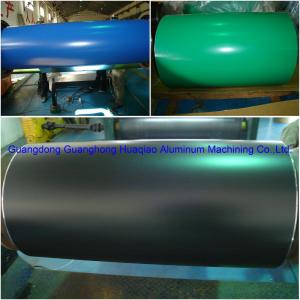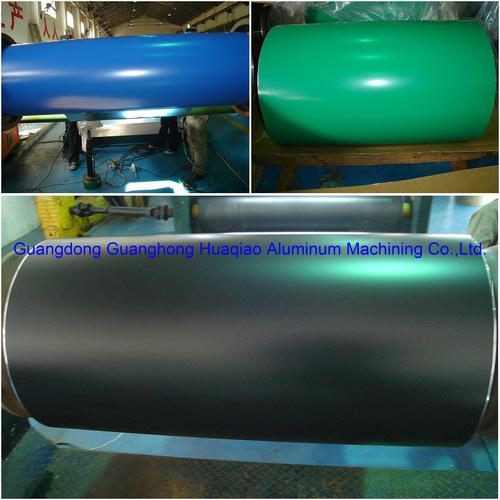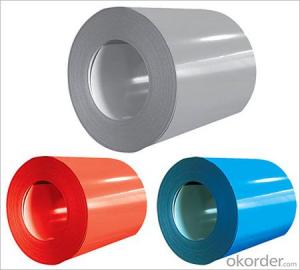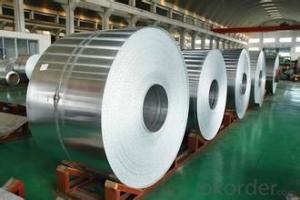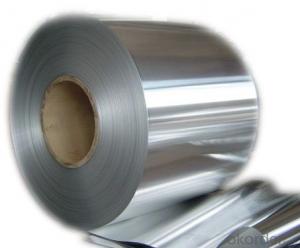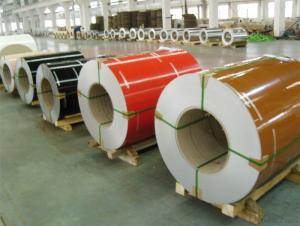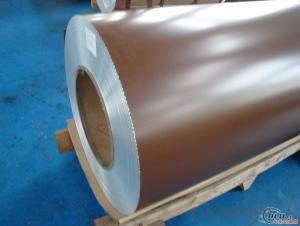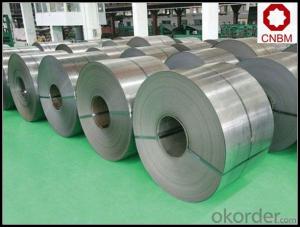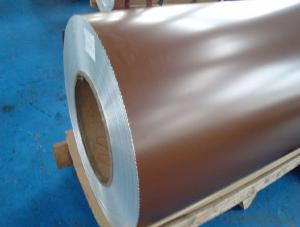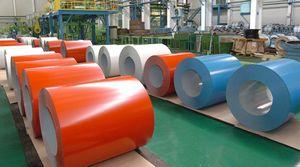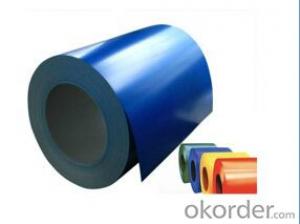Kynar 3003H16 PE Color Coating Aluminum Coil
- Loading Port:
- China Main Port
- Payment Terms:
- TT OR LC
- Min Order Qty:
- -
- Supply Capability:
- -
OKorder Service Pledge
OKorder Financial Service
You Might Also Like
Color coated aluminum magnesium alloy Al-Mn
Second,the Al-Mn-Mg alloys the characteristics of color coated aluminum
Colorcoated aluminum magnesium alloy Al-Mn alloy is used for the 3004 state of theAl-Mn-Mg aluminum alloy substrate, after de-ester, cleaning, passivation layerprocessing, and then painting on this basis, the international most advancedlevel of KANAR500 and HYLAR5000 Series Fluorocarbon (PVDF) resin coating, thecolor coated aluminum manganese alloy known international companies use theU.S. PPG, Sweden and the United States Weishi Bo Beca companies paint company,its products by the natural light exposure, Florida testing, with more than 20years of weathering quality assurance. Color coated aluminum magnesium alloyAl-Mn advantages of raw materials, its products have a high strength, corrosionresistance, high weather resistance and other characteristics, and according totheir own customers were asked to choose a different color palette, you cancolor integration, can co-exist to gorgeous effect.
Third,Al-Mn-Mg alloys the use of color coated aluminum
Ourcompany specializes in aluminum color coated aluminum manganese alloy has beenwidely used in large factories, exhibition halls, stadiums, airports, trainstation roof and ceiling decorative envelope system board. Thickness of thealuminum can choose different color coated aluminum magnesium alloy ofmanganese, by cutting, pressing, punching, bending and other follow-up moldingprocess for large span, the larger the overall roof, wall decorative panelsused in construction; You can also cut into small panels by bending, stampingmold, etc., for indoor decorative roof plate; also with polyurethane foam,bonded aluminum honeycomb composite construction for energy-saving decorativewall plates.
Fourth,the development prospects
As the field of building decoration materials, the continuous improvementrequirements, as poor performance of color coated steel corrosion, rust, yellowrust after a large amount of the deficiency of serious impact on the building'soverall appearance, the urgent need to develop a color plate with bothstrength, but also overcome the shortcomings of color-coated steel, while thereare long-term durability of new materials, building decoration, used inairports, commercial buildings, train stations, subways, hospitals and otherarchitectural decoration. The Al-Mn-color coated aluminum magnesium alloymaterials precisely meet these requirements, with the expanding domesticdemand, strengthen public infrastructure under the principle of color coatedaluminum magnesium alloy of manganese will become an increasingly widespreaduse of aluminum, a good prospect.
- Q: How are aluminum coils joined in a continuous process?
- Aluminum coils are joined in a continuous process using various techniques such as welding, brazing, and adhesive bonding. Welding is a common method used to join aluminum coils together. It involves melting the edges of the coils and then fusing them together. This can be achieved through various welding processes such as TIG (Tungsten Inert Gas) welding, MIG (Metal Inert Gas) welding, or laser welding. These methods provide a strong and durable bond between the coils. Brazing is another technique used for joining aluminum coils. It involves heating the coils and using a filler material with a lower melting point than the aluminum to create the joint. The filler material, often a brazing alloy, is applied to the joint area, and when heated, it melts and flows into the gap between the coils, forming a solid bond upon cooling. Adhesive bonding is also employed in the continuous joining of aluminum coils. This method involves applying a specialized adhesive or glue to the surfaces of the coils that need to be joined. The adhesive is carefully selected to have excellent bonding properties with aluminum. The coils are then pressed together, and the adhesive cures, creating a strong and reliable bond. Each joining technique has its advantages and is chosen based on factors such as the application requirements, the type of aluminum being used, and the desired level of strength and durability. The choice of joining method in a continuous process depends on the specific needs of the production line and the final product.
- Q: What are the different coil transportation options for aluminum coils?
- The different coil transportation options for aluminum coils include truck transportation, rail transportation, and container transportation.
- Q: Are there any limitations to using aluminum coils?
- Yes, there are several limitations to using aluminum coils. Firstly, aluminum coils are more expensive compared to other coil materials such as copper. This can be a limiting factor for individuals or businesses with budget constraints. Secondly, aluminum coils have lower thermal conductivity than copper coils. This means that they are less efficient at transferring heat, which can result in decreased performance in some applications. Additionally, aluminum is more susceptible to corrosion and oxidation compared to other materials. This can be a limitation in environments that are highly corrosive, such as coastal areas or industrial settings. Furthermore, aluminum coils are generally not suitable for high-pressure applications. They are more prone to leaks or failures under high pressure, which can limit their use in certain HVAC systems or refrigeration units. Lastly, aluminum coils are not as malleable as copper coils, making them more difficult to work with during installation or repair. This can lead to increased labor costs or potential damage to the coils during handling. Overall, while aluminum coils have their advantages such as being lightweight and environmentally friendly, they also have limitations that need to be considered based on the specific application and requirements.
- Q: What house hold materials contain 100% pure aluminum. or where can i buy it. im making thermite, which ive made before so don't say, its dangerous don't do it, but do i need 100% pure aluminum or will some aluminum alloy with like 90% aluminum work?????
- Aluminum foil is your best bet. According the the Reynold's wrap web site, their foil is 98.5% aluminum.
- Q: What are the differences among various types of steel wires and their respective coiling techniques?
- <p>Yes, there are differences between different types of steel wires and their coiling methods. Steel wires can be categorized based on their composition, strength, and use, such as carbon steel, stainless steel, and alloy steel wires. Each type has unique properties that affect their coiling methods. For instance, carbon steel wires are strong and ductile, suitable for standard coiling techniques, while stainless steel wires offer corrosion resistance and may require special handling to prevent damage. The coiling methods also vary; some common ones include spool coiling, loop coiling, and pancake coiling. Each method has specific applications and considerations for wire diameter, tension, and storage. Understanding these differences is crucial for selecting the appropriate wire and coiling technique for a given application.</p>
- Q: Are aluminum coils suitable for high-gloss applications?
- Aluminum coils are indeed suitable for high-gloss applications. Aluminum has excellent reflective properties and can achieve a high level of shine and gloss when properly treated and finished. The metal's smooth surface and reflective nature allow it to enhance the appearance of high-gloss finishes, making it an ideal choice for applications where a shiny and polished look is desired. In addition to its aesthetic benefits, aluminum also offers several practical advantages for high-gloss applications. It is lightweight, durable, and resistant to corrosion, making it a long-lasting and low-maintenance option. Aluminum coils are also highly malleable, allowing them to be easily formed into various shapes and sizes, which is crucial for achieving the desired high-gloss design. Furthermore, aluminum coils can be coated with a variety of finishes, such as anodized coatings or high-quality paint systems, to enhance their durability and glossiness. These coatings provide an additional layer of protection against scratches, fading, and other forms of wear and tear, ensuring that the high-gloss appearance is maintained over time. In summary, aluminum coils are well-suited for high-gloss applications due to their reflective properties, versatility, and durability. When properly treated and finished, aluminum can provide a stunning and long-lasting glossy finish, making it a popular choice for various industries, including automotive, architecture, and interior design.
- Q: Can aluminum coils be used in marine applications?
- Yes, aluminum coils can be used in marine applications. Aluminum is a corrosion-resistant metal that provides excellent durability and strength, making it suitable for various marine environments. It is commonly used in boat building, marine equipment, and other marine applications due to its lightweight nature and resistance to saltwater corrosion.
- Q: How are aluminum coils processed for surface preparation?
- Aluminum coils undergo various surface preparation processes to ensure proper adhesion of coatings, improve corrosion resistance, and enhance overall appearance. The surface preparation steps typically include cleaning, degreasing, and etching. Firstly, the coils are cleaned to remove any dirt, dust, or other contaminants by using either mechanical or chemical methods. Mechanical cleaning involves using brushes, scrubbers, or high-pressure water spray to physically remove the surface impurities. Chemical cleaning, on the other hand, involves the use of mild alkaline or acidic cleaning agents that dissolve and remove contaminants. After cleaning, the coils are degreased to eliminate any residual oils or greases. Degreasing can be done using solvents or by employing an alkaline degreasing process. Solvent-based degreasers are applied to the coil surface, allowing them to dissolve and remove any oil or grease residues. Alkaline degreasing, on the other hand, involves immersing the coils in an alkaline solution that reacts with the grease, forming a soap that is then easily rinsed off. Once cleaned and degreased, the aluminum coils may undergo an etching process to enhance surface roughness and promote better adhesion of subsequent coatings. Etching is typically done using either chemical or electrolytic methods. Chemical etching involves immersing the coils in an acidic solution that removes a thin layer of aluminum oxide from the surface, creating a roughened surface. Electrolytic etching, on the other hand, uses an electrical current to remove the oxide layer. After surface preparation, the aluminum coils are usually rinsed with water to remove any residual cleaning or etching chemicals. The coils are then dried to ensure a clean and dry surface, ready for the application of coatings or further processing. Overall, the surface preparation of aluminum coils involves a combination of cleaning, degreasing, and etching processes to ensure a clean, smooth, and properly prepared surface for subsequent treatments.
- Q: What are the potential safety hazards when using a soldering iron on copper or aluminum coils?
- <p>Using a soldering iron to solder copper or aluminum coils can pose safety risks. Copper and aluminum can react when joined, potentially leading to a galvanic corrosion. Additionally, the high heat from the soldering iron can cause the metal to expand or deform, especially if not handled properly. Always ensure proper ventilation to avoid inhaling fumes from the soldering process. Wear heat-resistant gloves and safety glasses to protect against burns and flying debris. Ensure the work area is clear of flammable materials to prevent fire hazards.</p>
- Q: Which would you guys recommend to a 13 year-old? I used a wooden bat at my last game, and I got a double to the left field wall, I don't think i've done that good with an aluminum bat all year. Should I continue using the wooden one? What do you guys think?
- Wood bats are better for the sport, but aluminum bats are better for the environment. To lighten bats they take too much off the handle, which makes wooden bats prone to breaking, which means a lot of trees getting cut down. Almost no one would willingly use a heavier bat, so unless leagues set handle thickness requirements that's unlikely to change. The argument against aluminum of course is that they give hitters an edge over pitchers. Pitchers don't like them because they let up more home runs, and because the ball comes back up the middle a lot faster. If leagues were really concerned about this they could create better rules governing what sorts of bats you can use. It's not hard to imagine that they could invent an aluminum bat that would perform more like a wooden bat. They've tried using different woods and that's let to all sorts of controversy. This bat hits to well; that bat splinters. As a kid I mostly played pick up games. You didn't tend to see a lot of hard throwing pitchers, so I actually preferred a heavier bat to keep me from jumping out to fast. Sometimes I'd even use a fungo bat, at least until my friends caught on.
Send your message to us
Kynar 3003H16 PE Color Coating Aluminum Coil
- Loading Port:
- China Main Port
- Payment Terms:
- TT OR LC
- Min Order Qty:
- -
- Supply Capability:
- -
OKorder Service Pledge
OKorder Financial Service
Similar products
Hot products
Hot Searches
Related keywords
